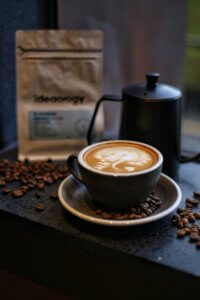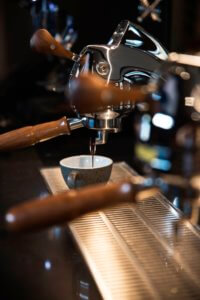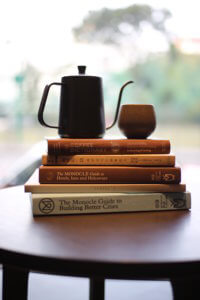“Coffee is a daily essential for most of us. From waking up to the aroma of freshly roasted beans to greet us good morning to taking that first initial sip that feels as intimate as a first kiss, the caffeinated drink is very much integrated into our everyday lives. With that said, the art of roasting, brewing and drinking coffee is a significant part of our brand identity at Page Hotels, which is evident in our mixed-use lobby acting as both a hotel lobby and an urban chic coffee shop. To understand more about the artisanal craft of brewing and drinking coffee, we sat down with Chester Tam, Owner of Barista Caffe & World Barista Champion Judge, to discuss everything we know and thought we knew about coffee. ”
Coffee Exploration with Chester Tam
As a coffee professional, we would love a quick crash course about all things coffee. Can you tell us what type of coffee products are in the market today?
Coffee Beans/Grounded Coffee – Out of the 4 that I mention, this is by far the freshest. Usually these coffee beans will be roasted within the week or the month and packaged in an airtight canister to maintain its quality. You can take it home and grind the fresh coffee beans before brewing it, using your preferred method of choice – be it the classic pour-over technique or French press. Your beans’ greatest enemies are air, moisture, heat, and light so be sure to store the beans in the freezer if you are not using it to maintain its fresh roasted flavour!
Instant Coffee – Another name for this is soluble coffee, which is a beverage derived from brewed coffee that enables people to quickly prepare hot coffee by adding hot water to the powder or coffee crystals and stirring. Coffee powder, a form of instant coffee, is made by spraying a fine mist of liquid coffee through very hot, dry air, which then turns into powder. The other method is called freeze-drying in which the liquid is forced from the frozen coffee through chemical sublimation.
RTD Coffee – Also known as “ready-to-drink coffee”, these pre-brewed coffees are packaged into bottles and then distributed to supermarkets and convenience stores for public consumption. These are considered quick-to-go coffees, which is convenient when you want a quick energy boost or fast pick-me-up but it is not exactly the freshest.
Coffee Capsule – Essentially, this is coffee packaged in a disposable capsule or pod that is inserted directly into the machine. It is your typical Nestlé Nespresso capsules which come in a variety of flavours and brands in the market today, depending on which coffee machine you use. With an increasing demand for quality house coffee made easy right in the comfort of your own home, coffee capsules are your safest bet for quick and easy coffee.
Coffee comes in many variations, from an Espresso Solo to a Caffè Americano. Can you name all the variations and how each one is prepared?
Espresso Solo – As the name suggests, Espresso (meaning “express”) is a full-flavored, concentrated form of coffee that is served in shots, with each shot measuring about 1 ounce. Made by forcing pressurized, hot water through very finely ground coffee beans, the espresso is rich in flavour and is meant to be sipped slowly so you can enjoy every last drop.
Espresso Doppio – By itself, espresso is served in shots with each shot measuring about 1 ounce. Double espressos, commonly referred in Italian as “Espresso Doppio” are two shots (Doppio meaning “double”) and are more popular than single espressos. An espresso doppio usually contains 40-60ml of coffee concentrate.
Espresso Macchiato – Macchiato means “stained” or “spotted” so the literal translation of caffè macchiato is “stained coffee”, or coffee with a spot of milk. An espresso topped with a tablespoon of steamed-milk foam, the macchiato gives coffee connoisseurs the perfect middle ground between an espresso and a cappuccino. It doesn’t pack as much of a punch as an espresso shot, but it’s also stronger than your regular cappuccino.
Espresso Cortado – A beverage consisting of espresso mixed with an equal amount of warm milk. The milk is added in to reduce the acidity. The milk in a cortado is steamed, but not frothy and texturized as in many Italian coffee drinks.
Caffé Americano – This classic coffee beverage is prepared by adding hot water to 1-2 shots of espresso. Prepared in one 6-ounce cup, the recommended ratio varies from half-and-half to 1/3 espresso and 2/3 water. This no-milk alternative to drip coffee tends to be richer so you can truly taste the flavour of the bean.
Caffé Latte – The term “latte” comes from shortening the Italian term caffé latte, meaning “milk coffee”. A latte is prepared by fusing together espresso (1/6 or 1-2 shots), steamed milk (4/6 or 5-6 oz.) and milk foam (1/6 or a thin top layer) to give you that ultra-creamy velvety texture.
Cappuccino – Cappuccinos are often considered the true test of a barista’s skills due to its structure. Ideally, it should be 1/3 espresso, under 1/3 steamed milk and 1/3 airy foamed milk, all ingredients split evenly into thirds. The texture is smooth, creamy and goes down just perfectly.
Cafe au Lait – Created in France, “café au lait” literally means “coffee with milk” in French. A café au lait is created using brewed coffee and steamed milk. The drink is made up of one part coffee and one part steamed milk, minus the foam. Drink it the way the French do by serving it in a bowl and holding it with both hands!
Caffé Mocha – Caffè Mocha is a marriage made in heaven, a flawlessly balanced combination of espresso, milk and chocolate. If you have a sweet tooth and want to truly indulge, add some whipping cream for that extra sugar rush.

What’s in a Latte? The term “latte” comes from shortening the Italian term caffé latte, meaning “milk coffee”
There are numerous brewing techniques, from an espresso machine to different coffee brewing devices. Can you tell us how the espresso machine works?
A manual espresso machine is piston driven and requires the user to pump a lever to generate the pressure needed to pull a shot. To start, the ground coffee is placed in a potter filter before brewing. The pressure level is then adjusted, depending on how finely ground the coffee is to extract its full flavour. Operating one of these machines requires precision and focus on the part of the brewer, but it can be quite rewarding to successfully pull your own shot. There is a plethora of espresso machine options in the market today, from more compact at-home coffee machines like Nespresso to full-fledged over-the-top espresso machines you see operating in coffee shops. You can find one that meets your coffee needs. The espresso machine we use at Page148 is the revolutionary MODBAR, a state-of-the-art three-part gear possessing cutting-edge technology that is designed to work both together and individually to provide our guests with the most flavourful cup of coffee. With our MODBAR situated at the entrance of the hotel lobby, hotel guests and coffee shop customers alike get an up-close and personal encounter with our baristas to understand the artisanal craft of coffee brewing.

At Page148, our revolutionary MODBAR is purposely designed to allow our guests to interact with our baristas while they serve up a flavourful cup of coffee
For something a little more compact and easy to use at home, brewing devices have become largely popular, as we bid farewell to the ancient instant coffee. What are the different brewing devices that can offer quality taste right in the comfort of your home?
Dripper – A coffee dripper is most certainly worth investing if you want to enjoy a freshly brewed cup of coffee right at home. Put a paper filter inside the dripper, then level out the grounded coffee as you pour it into the filter. Once you have done that, gently pour the water (ideal temperature should be between 195 to 205 degrees Fahrenheit) in a circular motion for a more balanced pour-over coffee.
French press pot – The French press pot is also known as a coffee press, a coffee brewing device invented by Paolini Ugo and patented by Italian designer Attilio Calimani and Giulio Moneta in 1929. The French press pot comprises of a cylindrical glass carafe and a stainless steel mesh filter to separate the coffee grounds from the water. The grounds stay at the bottom and the strained coffee stays above the filter, ready to pour.
Clever – The clever is just like other conventional drippers, combining the best features of French press and filter drip brewing. With French press brewing, you can control steeping or infusion time, but heat loss and sediment in the cup may be a drawback. Brewing with a paper filter is easy and convenient, but the problem is lack of control over steeping time. By adding a stopper to a filter cone, the clever combines control over steeping time with a sediment-free cup.
Aeropress – Invented in 2005 by Alan Adler, the aeropress is a device in which the coffee is steeped for 10–50 seconds and then forced through a filter by pressing the plunger through the tube, providing a classic taste of an espresso with the texture and simplicity of a traditional drip.
